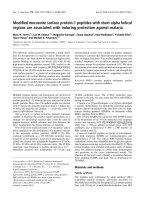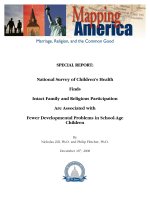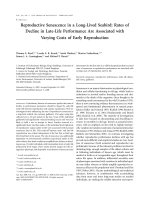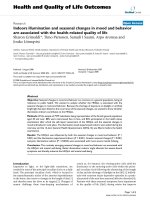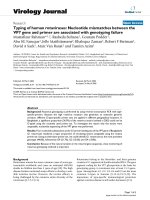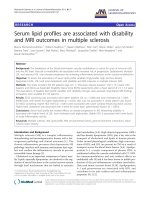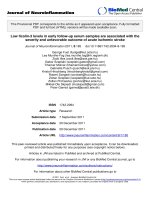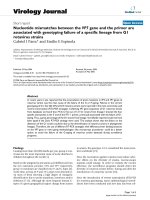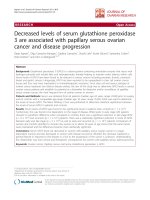Tertiary lymphoid structures are associated with higher tumor grade in primary operable breast cancer patients
Bạn đang xem bản rút gọn của tài liệu. Xem và tải ngay bản đầy đủ của tài liệu tại đây (1.85 MB, 11 trang )
Figenschau et al. BMC Cancer (2015) 15:101
DOI 10.1186/s12885-015-1116-1
RESEARCH ARTICLE
Open Access
Tertiary lymphoid structures are associated with
higher tumor grade in primary operable breast
cancer patients
Stine L Figenschau1, Silje Fismen2, Kristin A Fenton1, Christopher Fenton3 and Elin S Mortensen1,2*
Abstract
Background: Tertiary lymphoid structures (TLS) are highly organized immune cell aggregates that develop at sites of
inflammation or infection in non-lymphoid organs. Despite the described role of inflammation in tumor progression,
it is still unclear whether the process of lymphoid neogenesis and biological function of ectopic lymphoid tissue in
tumors are beneficial or detrimental to tumor growth. In this study we analysed if TLS are found in human breast
carcinomas and its association with clinicopathological parameters.
Methods: In a patient group (n = 290) who underwent primary surgery between 2011 and 2012 we assessed the
interrelationship between the presence of TLS in breast tumors and clinicopathological factors. Prognostic factors
were entered into a binary logistic regression model for identifying independent predictors for intratumoral TLS
formation.
Results: There was a positive association between the grade of immune cell infiltration within the tumor and
important prognostic parameters such as hormone receptor status, tumor grade and lymph node involvement. The
majority of patients with high grade infiltration of immune cells had TLS positive tumors. In addition to the degree of
immune cell infiltration, the presence of TLS was associated with organized immune cell aggregates, hormone
receptor status and tumor grade. Tumors with histological grade 3 were the strongest predictor for the presence of
TLS in a multivariate regression model. The model also predicted that the odds for having intratumoral TLS formation
were ten times higher for patients with high grade of inflammation than low grade.
Conclusions: Human breast carcinomas frequently contain TLS and the presence of these structures is associated
with aggressive forms of tumors. Locally generated immune response with potentially antitumor immunity may
control tumorigenesis and metastasis. Thus, defining the role of TLS formation in breast carcinomas may lead to
alternative therapeutic approaches targeting the immune system.
Keywords: Immune cell infiltration, Tertiary lymphoid structures, Breast cancer, Tumor, Adaptive immune response
Background
A growing number of publications has described the
complex architecture of immune cell infiltration in human solid tumors [1]. Immune responses may develop
ectopically at sites of inflammation or infection independently of secondary lymphoid organs [2-4]. The cellular
* Correspondence:
1
RNA and Molecular Pathology Research Group, Department of Medical
Biology, Faculty of Health Sciences, University of Tromso, N-9037 Tromso,
Norway
2
Department of Pathology, University Hospital of North Norway, N-9038
Tromso, Norway
Full list of author information is available at the end of the article
composition of immune cell infiltrates in the tumor
microenvironment varies and is heterogeneous, containing innate immune cells such as macrophages,
dendritic cells, natural killer cells, granulocytes and
mast cells [1]. In addition cells of the adaptive linages,
B and T lymphocytes have been observed. Premalignant and in situ lesions, as well as invasive carcinomas
of the breast, contain immune cell infiltrates in the
neoplastic stroma, indicating that the tumor progression is linked to abundant infiltration of immune cells
[5]. Several studies support the notion that spontaneous adaptive responses can be elicited by the host
© 2015 Figenschau et al.; licensee BioMed Central. This is an Open Access article distributed under the terms of the Creative
Commons Attribution License ( which permits unrestricted use, distribution, and
reproduction in any medium, provided the original work is properly credited. The Creative Commons Public Domain
Dedication waiver ( applies to the data made available in this article,
unless otherwise stated.
Figenschau et al. BMC Cancer (2015) 15:101
against tumor cells. This is believed to be a specific
anti-tumor response rather than randomly recruited
lymphocytes from the circulation [6-9]. The notable
presence of these immune cells, especially the lymphocytes and antigen presenting dendritic cells, has provided evidence that certain tumors can elicit such an
immune response. The development of ectopic lymphoid tissue, or tertiary lymphoid structures (TLS), in
tumors has been described in several other neoplastic
diseases such as lung cancer [10,11], colorectal cancer
[12,13], malignant melanoma [14,15], as well as being
a key feature of chronic inflammatory autoimmune
and infectious diseases, including rheumatoid arthritis
[16,17], Sjögren’s syndrome [18,19], and Helicobacter
pylori-induced gastritis [20,21].
TLS that develop within the tumor resemble the
organization of immune cells in secondary lymphoid
organs, in that they contain follicles comprising B lymphocytes and follicular dendritic cells (FDC), with surrounding areas of T lymphocytes and subpopulations
of dendritic cells (DC). Following antigen stimulation,
B lymphocytes and follicular helper T (Tfh) cells in
the B cell zone of these follicles express Bcl6 which is
unique for germinal centers (GC) [22]. High endothelial venules (HEV), blood vessels specialized for regulation of lymphocyte trafficking from lymphatic organs
into peripheral tissues, are also described in breast
tumors [23]. HEV are participating in the development
and maintenance of chronic inflammation as they are
essential for regulating the extravasation of lymphocytes into the inflamed areas and tumor tissue. HEV
are normally not found in non-neoplastic tissue. They
are generally restricted to lymphoid tissues and organs,
indicating the importance of specialized vascular systems in the development of TLS [23].
The patient’s prognosis and the clinical outcome of
breast cancer are influenced by tumor related factors,
including histological tumor grade, tumor size, lymph
node involvement and hormone receptor status [24].
Several studies describe the relationship between immune contexture in tumors and the impact on patients’
clinical outcome. Tumors with higher numbers of immune cell infiltrates, especially lymphocytes, are in general associated with improved survival [25,26]. Patients
with tumor infiltrating T lymphocyte populations are
shown to have favourable clinical outcome, especially
tumors with higher levels of CD8+ T lymphocytes are
associated with better patient survival rates [27-29]. Even
though tumor infiltrating CD20+ B lymphocytes play a
role in anticancer immune responses and are a common
occurrence in breast tumors [9,30], the role in patients’
clinical outcome is still unclear. It is postulated that B
lymphocytes are an independent predictor associated
with patients’ outcome and associated with higher tumor
Page 2 of 11
grade [31,32]. However, the current opinion is based on
conflicting results, suggesting that further studies have
to determine whether B lymphocytes play a role in
tumor progression and in prediction of cancer specific
survival [33].
Consistent with previous findings, tumors behave as
triggers for inflammation and the complex interaction
between tumor cells and the host inflammatory response
is a key feature of carcinogenesis [5,34]. Several studies
have shown an important relationship between tumor
infiltrating immune cells and the clinical outcome for
breast cancer patients. However, it is still unclear if a
locally produced immune response, with the formation
of TLS within the tumor will have an influence on the
development of cancer and patients survival. Although
the presence of organized immune cell aggregates in primary operable breast cancers has been shown previously
[6,8,22,23,35-37], this is, to our knowledge, the first time
the characterization of TLS has been described in a
larger patient group of breast carcinomas with its association to clinicopathological features. Taken together, our
main results showed more organized immune cell aggregates in tumors with higher grade of immune cell
infiltration compared with less inflamed tumors. The
presence of intratumoral TLS was associated with higher
degree of immune cell infiltration and higher histological
tumor grade.
Methods
This study was approved by the Regional Committees
for Medical and Health Research Ethics (REC; Norway,
2010/1523). All analyses were performed on tissue specimen previously collected for diagnostic purposes. The
study was considered of significant interest for society,
the participant’s welfare and integrity was safeguarded
and the material was anonymized. Since all these criteria
were fulfilled the Regional Ethics committee agreed to
use the material for study purposes.
Clinical samples
This study was conducted on patients who underwent
primary surgery between 2011 and 2012 at the University hospital of North Norway (UNN), Tromsø. We
used archived formalin-fixed paraffin-embedded (FFPE)
specimens obtained from the Department of Pathology
(UNN) with the corresponding hematoxylin and eosin
(HE) slides from all patients. A total of 290 patients
with invasive carcinoma of no special type (NST),
formerly known as invasive ductal carcinoma (IDC)
[38], invasive lobular carcinoma (ILC), ductal carcinoma in situ (DCIS) and other types of invasive breast
carcinomas were included in the study. None of the
patients included in this study received adjuvant therapy before surgery, nor did they have any other known
Figenschau et al. BMC Cancer (2015) 15:101
Page 3 of 11
Table 1 Patients’ demographics and clinicopathological
characteristics (n = 290)
Table 1 Patients’ demographics and clinicopathological
characteristics (n = 290) (Continued)
Age at diagnosis
Patients (n, %)
TLS formation*
<40
7 (2.4)
Negative
175 (61.4)
40-50
53 (18.3)
Positive
110 (38.6)
51-60
71 (24.5)
>60
159 (54.8)
Diagnosis
Invasive carcinoma (NST)
208 (71.7)
ILC
31 (10.7)
DCIS
33 (11.4)
Other
18 (6.2)
DCIS status*
Invasive carcinomas without DCIS
93 (36.3)
Invasive carcinomas with DCIS
163 (63.7)
DCIS grade
DCIS grade 1-2
77 (39.3)
DCIS grade 3
119 (60.7)
Hormone receptor status
Abbreviations: NST invasive carcinoma of no special type, ILC invasive lobular
carcinoma, DCIS ductal carcinoma in situ, other invasive carcinomas include:
tubular carcinoma, cribriform carcinoma, mucinous carcinoma, medullary
carcinoma, apocrine carcinoma, metaplastic carcinoma, papillary carcinoma,
ER estrogen receptor, PR progesterone receptor, HER2 human epidermal
growth factor receptor 2, TLS tertiary lymphoid structures, na not analysed.
*Patient(s) data missing.
malignant diseases. Patient demographics and baseline
clinicopathological characteristics are shown in Table 1.
DCIS grade was evaluated according to the Van Nuys
classification [39]. Histological tumor grade was assessed
by the Nottingham Grading System [40]. The cut off
values for Estrogen (ER) and progesterone (PR) were 10%.
Tumors demonstrating HER2 protein overexpression or
amplified HER2 gene (IHC 3+ or FISH HER2 gene ratio
≥2) were considered to be positive.
ER neg / pos / na
44 (15.2) / 210 (72.4) / 36 (12.4)
Assessment of tumor immune cell infiltrate
PR neg / pos / na
59 (20.3) / 122 (42.1) / 109 (37.6)
HER2 neg / pos / na
215 (74.1) / 40 (13.8) / 35 (12.1)
Histopathological analysis of full-faced HE stained tissue
sections were used to assess the overall level of immune
cell infiltration in the breast tumors. Using routine histology, the patient samples were evaluated based on the
total amount of immune cell infiltrate, both in the central areas of the tumor and at the invasive margin, then
categorized into the following groups: no immune cell
infiltrate, mild infiltrate, moderate infiltrate and extensive immune cell infiltrate. By applying this definition,
we further divided the categories into two groups: low
grade and high grade infiltration of immune cells. The
two pathologists (ESM and SF) independently performed
the categorizing and had no knowledge of the patients’
background history.
Tumor size
≤20 mm
159 (62.1)
21- 50 mm
87 (34.0)
>50 mm
10 (3.9)
Histological grade*
1
85 (33.3)
2
121 (47.5)
3
49 (19.2)
Lymph node involvement
Negative
204 (70.3)
Positive
86 (29.7)
Immunohistochemistry
Involved lymph nodes
1-3
62 (72.1)
>3
24 (27.9)
Immune cell infiltration*
No infiltration
39 (13.5)
Mild infiltration
144 (49.8)
Moderate infiltration
90 (31.1)
Extensive infiltration
16 (5.6)
Aggregate formation*
Negative
143 (49.5)
Positive
146 (50.5)
Tumor samples that contained organized aggregates of
immune cells, judged by HE staining, were further
assessed by immunohistochemical analyses. FFPE serial
sections (4 μm) were deparaffinized and dehydrated in
xylene and graded alcohols. Antigen retrieval was performed by microwave treatment in 10 mM sodium
citrate buffer (pH 6.0) for 20 min. Endogenous peroxidase activity was blocked with 3% H2O2 for 10 min and
non-specific binding was blocked with 10% goat serum
(Invitrogen™, Life Technologies) for 30 min. Sections
were incubated with unlabelled primary antibody for
30 min and Polink-2 HRP Plus DAB kit (Golden Bridge
International, Inc., USA) was used as detection system
according to the manufacturers’ protocol. For the detection of PNAd + HEV, sections were incubated with purified
Figenschau et al. BMC Cancer (2015) 15:101
Page 4 of 11
goat anti-rat light chain specific HRP conjugated polyclonal
antibody (1:500, AP202P; Millipore) for 30 min prior to
reaction with DAB substrate-chromogen (Golden Bridge
International, Inc., USA). Finally, sections were counterstained with hematoxylin and rehydrated in graded alcohols and xylene. All reactions were performed at room
temperature, if not stated otherwise. Human lymph node,
tonsil and breast tumor were used as positive controls.
Negative controls were performed by omitting the primary
antibody. Immunohistochemical analyses using the platform specific assays on BenchMark XT (Ventana Medical
systems Inc., USA) were performed according to the
manufacturers’ instructions. Antibodies used for immunohistochemical analyses are summarized in Table 2.
Statistical analyses
Determination of interobserver agreement was assessed
by the Cohen’s kappa statistics (κ). Values of κ from 0.60
to 0.79 are considered good, and above 0.80 excellent.
Baseline descriptive statistics are reported as frequencies
and percentages. Interrelationship between variables was
assessed using contingency tables; Phi analyses for
dichotomous variables and Spearman rank order correlation for ranked data. The variables with the highest
level of significance and important prognostic factors
were entered into a regression model. Binary logistic
regression analysis with the fixed entry method was performed in order to identify significant predictors for the
presence of TLS in patient tumors. The following diagnostic predictors were included in the regression analysis
together with the lymphocytic parameters: tumor size,
histology grade and clinical nodal status. For all statistical analyses, if not stated otherwise, p values < 0.05
(two-tailed) were considered statistically significant. Statistical analyses were performed using SPSS software
version 22 (SPSS Inc., Chicago, IL, USA).
Results
The demographics and baseline clinicopathological characteristics of patients with primary operable breast
carcinomas included are shown in Table 1.
Characterization of tertiary lymphoid structures in breast
carcinomas
Tumors from all patients who underwent primary surgery in the period 2011 to 2012 were categorized into
four groups based on the degree of immune cell infiltration as shown in Figure 1A-D. The distribution of
patient samples showed that 13.5% had no immune
cell infiltration (Figure 1A), 49.8% had mild infiltration
(Figure 1B), 31.1% had moderate infiltration (Figure 1C),
and 5.6% were categorized as tumors with extensive infiltration of immune cells (Figure 1D and Table 1). The
interobserver κ value for the categorical parameter (no
infiltrate, mild infiltrate, moderate infiltrate, extensive
infiltrate) was 0.78 (p <0.001).
The organization of tumor infiltrating immune cells
was characterized by immunohistochemical detection
(Figures 2 and 3). The immune cell aggregates which
were TLS positive showed the presence of CD20+ B lymphocytes within the follicles, with areas of CD3+ T lymphocytes resembling the highly organized structures of
secondary lymphoid organs (Figure 2B and C). CD21+
FDC formed a tight network in the B cell zone within the
follicle as shown in Figure 3A and B. Consistent with previous findings [9], the majority of CD3+ T lymphocytes
in the T cell zone were of the CD4+ T cell subset
(Figure 3C). CD8+ T lymphocytes were moderately
dispersed within the T cell zone (Figure 3D). Moreover, Figure 3E shows Bcl6+ GC B lymphocytes and
Tfh cells which were detected in most of the organized lymphoid aggregates. HEV, although restricted
to lymphoid tissue, were also found in the tumor
Table 2 Primary antibodies used for immunohistochemical analyses
Antigen
Manufacturer
Cat. no
Clone
Species
Control
Dilution
Bcl6
Ventana
760-4241
GI191E/A8
Mouse IgG1
Lymph node
Pre-diluted
CD3
Ventana
790-4341
2GV6
Rabbit IgG
Lymph node
Pre-diluted
CD4
Ventana
790-4423
SP35
Rabbit
Lymph node
Pre-diluted
CD8
Ventana
790-4460
SP57
Rabbit
Lymph node
Pre-diluted
CD20
Ventana
760-2531
L26
Mouse IgG2a/κ
Lymph node
Pre-diluted
CD21
Ventana
760-4245
2G9
Mouse IgG2a
Lymph node
Pre-diluted
CD21
Ventana
760-4438
EP3093
Rabbit IgG1
Lymph node
Pre-diluted
CD21
Abcam
ab75985
EP3093
Rabbit IgG
Tonsil
1:100
ER
Ventana
790-4325
SP1
Rabbit IgG
Breast carcinoma
Pre-diluted
PR
Ventana
790-4296
1E2
Rabbit IgG
Breast carcinoma
Pre-diluted
HER2/neu
Ventana
790-2991
4B5
Rabbit
Breast carcinoma
Pre-diluted
PNAd
Biolegend
120801
MECA-79
IgM,κ
Lymph node
1:50
Figenschau et al. BMC Cancer (2015) 15:101
Page 5 of 11
Figure 1 Characterization of immune cell infiltrate in breast carcinomas. Invasive human breast carcinomas with A) no immune cell
infiltrate B) mild infiltrate C) moderate infiltrate and D) extensive infiltrate. All slides are HE stained and at the same magnification (100X).
tissue adjacent to the aggregates. HEV were typically
found in the T cell area of the lymphoid aggregates as
shown in Figure 3F. These vessels were not found at
other sites than within the TLS, nor in non-cancerous
areas of the breast (results not shown). Histopathological analyses revealed immune cell infiltrates with
aggregate formation in 50.5% of the patient samples
of which 38.6% were TLS positive (Table 1). Intratumoral TLS formation was found both in the periphery
of the tumor, the centre of the tumor as well as close
to adjacent tumor nests. The extent and size of these
structures within the tumor varied in the patient
samples.
Association between immune cell infiltration and
clinicopathological parameters
The relationship between the degree of immune cell
infiltration in tumors and patients’ clinicopathological
characteristics are shown in Table 3. The majority of the
patients who had tumor with high grade immune cell
infiltration (n = 106) were over 50 years, had invasive
carcinoma (NST) and accompanying DCIS component
Figure 2 Representative overview of lymphocytic infiltrate in breast tumor. Histology and immunohistochemical analyses performed on
breast tumor biopsies show the localization and distribution of lymphocytes in primary tumor of the breast. A) HE staining shows intratumoral
TLS with GC, B) CD20+ B lymphocytes forming follicles with surrounding area of C) CD3+ T lymphocytes, resembling highly organized structures
of secondary lymphoid tissue. Magnification 20X. Higher magnification of boxed area is shown in Figure 3.
Figenschau et al. BMC Cancer (2015) 15:101
Page 6 of 11
Figure 3 Characterization of tertiary lymphoid structures in breast carcinoma. Immunohistochemical detection of the indicated antigens in
serial sections of breast carcinoma with extensive immune cell infiltration. Tertiary lymphoid structures with germinal center formation were
detected by A) CD20+ B lymphocyte follicle comprising a network of B) CD21+ FDC, with C) CD4+ and D) CD8+ T lymphocytes in the T cell
zone. E) Bcl6+ germinal center B lymphocytes and Tfh cells were also observed within the B cell follicle with surrounding F) PNAd + HEV like
vessels. Positively stained antigens are shown by brown DAB staining. Magnification 100X.
within the tumor. None of these variables were significantly associated with higher grade of immune cell
infiltration. ER and PR hormone receptor status were
negatively associated (rϕ = −0.394 and −0.342, respectively, p < 0.01) with the grade of immune cell infiltration compared with HER2 status which was positively
associated (rϕ = 0.294, p < 0.01). There was a positive
association between the total level of immune cell
infiltration in tumors and tumor grade (rs = 0.384, p <
0.01). Patients who had higher grade of immune cell
infiltration also had higher tumor grades, where 47.2%
of the patients had tumor grade 2 and close to 40%
had tumor grade 3. There was a weak positive association between the level of immune cell infiltrate and
lymph node invasion (rϕ = 0.180, p < 0.01).
Association between TLS formation and
clinicopathological parameters
The association between the presence of TLS in tumors
and patients’ clinicopathological characteristics are shown
in Table 4. There was a strong positive association (rϕ =
0.796, p < 0.01) between detection of TLS and immune
cell aggregates formed in tumors. Tumor grade and the
level of immune cell infiltration were weakly associated
with TLS formation (rϕ = 0.294 and 0.567, respectively,
p < 0.01). We observed a negative association between
TLS formation and ER and PR positive tumors as
more TLS negative tumors were ER and PR positive
(rϕ = −0.342 and −0.308, respectively, p < 0.01). A weak
association between TLS positive tumors and the presence of HER2 receptor was observed within the tumors
Figenschau et al. BMC Cancer (2015) 15:101
Page 7 of 11
Table 3 Association between immune cell infiltration grade in tumors and clinicopathological parameters
p value
Low grade immune
cell infiltrate (n = 183)
High grade immune
cell infiltrate (n = 106)
r value
Age (≤50 / >50 years)
36 (19.7) / 147 (80.3)
24 (22.6) / 82 (77.4)
rφ = −0.035 0.549
Invasive carcinoma (NST) / ILC / DCIS /
Other invasive carcinomas
130 (71.0) / 22 (12.0) / 16 (8.7) / 15 (8.2) 77 (72.6) / 9 (8.5) / 17 (16.0) / 3 (2.8) rs = −0.019
0.743
DCIS status (Invasive DCIS − / Invasive DCIS +) 61 (36.7) / 105 (63.3)
31 (34.8) / 58 (65.2)
rφ = 0.019
0.761
DCIS grade (1–2 / 3)
15 (20.0) / 60 (80.0)
rφ = 0.311
<0.01
62 (51.2) / 59 (48.8)
Estrogen receptor status (ER − / ER +)
10 (6.1) / 154 (93.9)
33 (37.1) / 56 (62.9)
rφ = −0.394 <0.01
Progesterone receptor status (PR − / PR +)
20 (18.9) / 86 (81.1)
38 (51.4) / 36 (48.6)
rφ = −0.342 <0.01
HER2 status (HER2 − / HER2 +)
152 (92.1) / 13 (7.9)
62 (69.7) / 27 (30.3)
rφ = 0.294
<0.01
Tumor size (≤20 / 21–50 / >50 mm)
111 (66.9) / 47 (28.3) / 8 (4.8)
47 (52.8) / 40 (44.9) / 2 (2.2)
rs = 0.122
0.052
Tumor grade (I / II / III)
72 (43.6) / 78 (47.3) / 15 (9.1)
13 (14.6) / 42 (47.2) / 34 (38.2)
rs = 0.384
<0.01
Lymph node (− / +)
140 (76.5) / 43 (23.5)
63 (59.4) / 43 (40.6)
rφ = 0.180
<0.01
Involved lymph node (0 / 1–3 / >3)
140 (76.5) / 33 (18.0) / 10 (5.5)
63 (59.4) / 29 (27.4) / 14 (13.2)
rs = 0.187
<0.01
Abbreviations: NST invasive carcinoma of no special type, ILC invasive lobular carcinoma, DCIS ductal carcinoma in situ, ER estrogen receptor, PR progesterone
receptor, HER2 human epidermal growth factor receptor 2, rs spearman rank order correlation, rφ phi coefficient. A small number of patients did not have
complete data. Data presented as n (%).
studied, although more TLS negative tumors were HER2
negative (rϕ = 0.243, p < 0.01).
In order to identify significant predictors for intratumoral TLS formation a regression analysis was conducted using a fixed entry model. The variables of
interest that were entered into the binary logistic regression model are shown in Table 5. Histological
tumor grade 2 and 3 were associated with TLS formation in univariate analysis. Accordingly, multivariate
regression analysis identified tumor grade 3 as independent predictor for TLS formation. As shown in
Table 5, the odds ratio of 2.78 [CI, 1.06-7.27] indicates that the odds for having TLS positive tumors
were almost three times more likely for grade 3 tumors than for patients with grade 1 tumors. Another
significant independent parameter was the degree of
immune cell infiltration. The model predicts that the
odds of having TLS formation in tumors were more
than 10 times higher for patients with higher grade of
inflammation than lower graded infiltrated tumors.
Hence, patients with high grade inflammation are two
times more likely to have TLS formation than not.
Table 4 Association between presence of tertiary lymphoid structures in tumors and clinicopathological parameters
TLS negative tumors (n = 175)
TLS positive tumors (n = 110)
r value
p value
Age (≤50 / >50 years)
38 (21.7) / 137 (78.3)
21 (19.1) / 89 (80.9)
rφ = 0.032
0.595
Invasive carcinoma (NST) / ILC / DCIS /
Other invasive carcinomas
122 (69.7) / 22 (12.6) / 18 (10.3) / 13 (7.4) 81 (73.6) / 9 (8.2) / 15 (13.6) / 5 (4.5) rs = −0.038
0.518
DCIS status (Invasive DCIS − / Invasive DCIS +) 59 (37.8) / 97 (62.2)
30 (31.6) / 65 (68.4)
rφ = 0.063
0.316
<0.05
DCIS grade (1–2 / 3)
52 (45.2) / 63 (54.8)
24 (30.0) / 56 (70.0)
rφ = 0.153
Estrogen receptor status (ER − / ER +)
10 (6.5) / 144 (93.5)
31 (32.6) / 64 (67.4)
rφ = −0.342 <0.01
Progesterone receptor status (PR − / PR +)
20 (19.6) / 82 (80.4)
36 (48.6) / 38 (51.4)
rφ = −0.308 <0.01
HER2 status (HER2 − / HER2 +)
141 (91.0) / 14 (9.0)
69 (72.6) / 26 (27.4)
rφ = 0.243
<0.01
Tumor size (≤20 / 21–50 / >50 mm)
99 (63.5) / 48 (30.8) / 9 (5.8)
56 (58.9) / 38 (40.0) / 1 (1.1)
rs = 0.025
0.694
Tumor grade (I / II / III)
64 (41.3) / 75 (48.4) / 16 (10.3)
19 (20.0) / 45 (47.4) / 31 (32.6)
rs = 0.294
<0.01
Lymph node (− / +)
130 (74.3) / 45 (25.7)
70 (63.6) / 40 (36.4)
rφ = 0.113
0.056
Involved lymph node (0 / 1–3 / >3)
130 (74.3) / 34 (19.4) / 11 (6.3)
70 (63.6) / 27 (24.5) / 13 (11.8)
rs = 0.120
<0.05
Immune cell infiltration (low / high)
149 (85.1) / 26 (14.9)
32 (29.1) / 78 (70.9)
rφ = 0.567
<0.01
Aggregate formation (− / +)
143 (81.7) / 32 (18.3)
0 / 110 (100)
rφ = 0.796
<0.01
Abbreviations: TLS tertiary lymphoid structures, NST invasive carcinoma of no special type, ILC invasive lobular carcinoma, DCIS ductal carcinoma in situ, ER
estrogen receptor, PR progesterone receptor, HER2 human epidermal growth factor receptor 2, rs spearman rank order correlation, rφ phi coefficient. A small
number of patients did not have complete data. Data presented as n (%).
Figenschau et al. BMC Cancer (2015) 15:101
Page 8 of 11
Table 5 Logistic regression models for predicting TLS formation in breast carcinomas
Univariate analysis
Multivariate analysis
p value
OR
95% CI
≤20 mm
1.00
(Reference)
21 - 50 mm
1.40
0.82 - 2.40
0.22
>50 mm
0.20
0.02 - 1.59
0.13
Grade 1
1.00
(Reference)
Grade 2
2.02
1.08 - 3.80
<0.05
Grade 3
6.53
2.96 - 14.40
Immune cell infiltration (low / high)
13.97
7.78 - 25.09
Lymph node (− / +)
1.65
0.99 - 2.76
p value
OR
95% CI
1.00
(Reference)
0.84
0.42 - 1.70
0.63
0.14
0.01 - 1.42
0.09
1.00
(Reference)
1.53
0.72 - 3.26)
0.27
<0.01
2.78
1.06 - 7.27
<0.05
<0.01
10.80
5.54 - 21.05
<0.01
0.057
0.98
0.47 - 2.02
0.95
Tumor size (≤20 / 21–50 / >50 mm)
Tumor grade (I / II / III)
Abbreviations: OR odds ratio, CI confidence interval.
Tumor size or whether patients had lymph node
metastasis did not affect the detection of intratumoral
TLS formation.
Discussion
It is well established that tumors of a variety of cancer
types are commonly infiltrated with immune cells which
are organized in structures resembling conventional
secondary lymphoid organs [41]. For the first time, we
describe intratumoral TLS formation in a larger group
of breast carcinoma patients. Our study demonstrates
that TLS are frequently found in breast tumors with
higher degree of immune cell infiltration and higher
histological tumor grade. Breast carcinoma cells are
often closely associated with tumor infiltrating lymphocytes [42]. Invasive carcinomas (NST) are the most common type of breast cancer, but unlike subtypes such as
medullary and basal-like carcinomas characterized by
prominent inflammation, they have a more variable
lymphocytic infiltration [43]. Breast carcinomas often
contain infiltrating B and T lymphocytes, with dense
infiltrates occurring in approximately 20% of tumors,
and moderate infiltrates in about 50% [9,43].
Our results showed the presence of tumor-associated
TLS in about one third of the breast carcinomas. These
structures comprise distinct T cell zones and B lymphocytes segregated into follicles hosting functionally active
GC, exhibiting structural analogies with secondary
lymphoid tissues. The observed TLS were confined to
peritumoral areas, and were detected both in the periphery and central tumor nests. We did not observe these
structures in non-tumor areas, indicating that these
structures were tumor-associated and may be a response
to the tumor microenvironment. Consistent with our
findings, lymphoid neogenesis has been reported in
several other neoplastic diseases [10-15]. TLS are also
frequently observed in chronic inflammatory conditions
in which sustained lymphocyte activation occurs in the
presence of persistent antigenic stimuli [16-19]. Whether
TLS can generate an intratumoral immune response in a
way similar to secondary lymphoid organs is still
unclear. Experimental data from mouse models have
provided evidence that adaptive immunity can be initiated independently of secondary lymphoid organs [44].
Notably, studies have demonstrated that development of
TLS play a role in the induction of a local antitumor
immune response in neoplastic tissue in mice lacking
peripheral lymph nodes [45-47]. Recent data published
by Goc et al. suggests TLS as an important site for in
situ activation of tumor-associated lymphocytes and supports the contribution of these structures in generation of
a protective immune response in lung cancer [48]. Furthermore, Gu-Trantien et al. demonstrated that CXCL13producing Tfh cells located in GC of breast tumors are
associated with organized lymphoid structures that may
produce an antitumor immune reaction [22]. In line with
previous works, we observed Bcl6+ B lymphocytes and
Tfh cells within GC which argue for functional ectopic
centers in breast tumors. Given that extra-nodal activation
of lymphocytes occurs in tumor-associated TLS and facilitates induction of local immune reactions, it makes sense
that this phenomenon could be beneficial in antitumor
immunity.
It has become generally accepted that the immune
system exerts a dual role in carcinogenesis. Thus, one
can not rule out the opposite protumoral effect as the
tumor eradication by the immune system is often inefficient, and spontaneous or complete regression of established tumors are extremely rare [49]. The immunoediting
theory emphasizes that during tumor development and
progression, there is a dynamic interaction between the
host immune system and the developing tumor, a process
which describes the host-protective and tumor promoting
roles of the immune system [50]. Studies in mouse models
Figenschau et al. BMC Cancer (2015) 15:101
suggest that CCL21 secreting tumors may alter the locally
generated immune response by promoting tumor-induced
tolerance, which facilitates tumor progression [51]. In
addition, impairment of antitumoral T cell responses and
modulation of immune responses by immune complexes
might represent underlying mechanisms that also promote tumor progression [52]. The immunoediting theory
was recently further challenged by Ciampricotti et al. who
evaluated the role of adaptive immune responses in
tumorigenesis by establishing a mouse model of spontaneous HER2+ breast tumors. The study demonstrated that
the development of tumors were not suppressed by
immunosurveillance mechanisms or influenced by adaptive immune responses [53]. Interestingly, a recent study
showed decreased density of HEV and DC-LAMP+ DCs
around the DCIS component compared to invasive areas
in breast tumors, suggesting to be a key feature in the progression from in situ to invasive carcinoma [37]. However,
our results did not show a strong association between
the presence of TLS and DCIS components within the
invasive tumors. Taken together, there are examples
where TLS formation in neoplastic diseases is associated with promotion of tumorigenesis rather than generating a protective immune response. Still, the overall
morphology of a conventional secondary lymphoid
organ with Bcl6+ GC cells combined with specialized
population of DC and distinct T cell area are convincing findings of local adaptive immune response taking
place in these structures.
The major finding of our study demonstrated that
higher tumor grade was associated with intratumoral
TLS formation. Tumors with histological grade 3 are the
most aggressive types and are associated with worst
prognosis. Lymph node metastases are also associated
with worse prognosis independent of tumor grade. Our
results demonstrated a weak association between the
presence of intratumoral TLS and lymph node involvement. It is therefore important to address whether TLS
would influence the clinical outcome in a larger series of
breast cancer patients. The formation of TLS with morphologically and immunophenotypically identical features to a conventional secondary lymphoid organ is
intriguing, and adds to the findings of similar structures
in malignant tumors in other organ systems [10-15]. In
addition, as previously mentioned, immune cell infiltration in tumors is associated with prognosis and survival
of breast cancer patients. The distinct combination of
tumor infiltrating immune cells combined with lymphoid neogenesis may suggest TLS as a biomarker in
cancer. Hence, the importance of defining the immunophenotype, the location and the functionality of the
immune infiltrates in breast carcinomas may become
useful in predicting a patient’s prognosis. Careful studies
on the mechanisms of the immune reactions and their
Page 9 of 11
impact at different stages of disease should hopefully
result in an improved approach to targeted therapies.
Conclusion
In this study, we characterized tertiary lymphoid structures in breast cancer patients and addressed the question whether there was a relationship between immune
cells infiltrating human breast tumors, intratumoral formation of TLS and clinicopathological parameters. Our
main findings conclude that tumors with higher degree
of immune cell infiltration also have higher tumor grade.
In addition, intratumoral TLS formation was associated
with higher inflammation grade and higher tumor grade.
These findings support the notion that infiltrating immune cells are a common feature in breast cancer tumors
and that breast tumors frequently contain tertiary lymphoid structures.
Abbreviations
Bcl6: B-cell lymphoma 6 protein; CI: Confidence interval; CD: Cluster of
differentiation; DAB: 3,3’-Diaminobenzidine; DC: Dendritic cells; DCIS: Ductal
carcinoma in situ; ER: Estrogen receptor; FDC: Follicular dendritic cells;
FFPE: Formalin-fixed paraffin-embedded; GC: Germinal center; HE: Hematoxylin
and eosin; HER2: Human epidermal growth factor receptor 2; HEV: High
endothelial venules; HRP: Horseradish peroxidase; IDC: Invasive ductal
carcinoma; ILC: Invasive lobular carcinoma; NST: Invasive carcinoma of no
special type; OR: Odds ratio; PNAd: Peripheral node addressin; PR: Progesterone
receptor; Tfh: Follicular helper T cells; TLS: Tertiary lymphoid structures.
Competing interests
The authors declare that they have no competing interests.
Authors’ contributions
SLF, SF, KF and ESM developed the study design. SLF collected the clinical
data, carried out the immunohistochemical analyses and conducted the
statistical analyses. SF and ESM categorized the patients samples according
to degree of inflammation and reviewed the clinical information. KF and CF
were involved in interpreting the statistical data and results. SLF and SF
drafted the manuscript. All authors contributed to the editing of the
manuscript and approved the final version.
Acknowledgements
This study was supported by the Norwegian Cancer Society (2290738–2011).
We thank Stig E. Hermansen for support on the statistical analyses and
Natalya Seredkina for critical reading of the manuscript.
Author details
1
RNA and Molecular Pathology Research Group, Department of Medical
Biology, Faculty of Health Sciences, University of Tromso, N-9037 Tromso,
Norway. 2Department of Pathology, University Hospital of North Norway,
N-9038 Tromso, Norway. 3The Microarray Platform, Faculty of Health
Sciences, University of Tromso, N-9037 Tromso, Norway.
Received: 25 April 2014 Accepted: 23 February 2015
References
1. Fridman WH, Pages F, Sautes-Fridman C, Galon J. The immune contexture
in human tumours: impact on clinical outcome. Nat Rev Cancer.
2012;12:298–306.
2. Aloisi F, Pujol-Borrell R. Lymphoid neogenesis in chronic inflammatory
diseases. Nat Rev Immunol. 2006;6:205–17.
3. Drayton DL, Liao S, Mounzer RH, Ruddle NH. Lymphoid organ development:
from ontogeny to neogenesis. Nat Immunol. 2006;7:344–53.
4. van de Pavert SA, Mebius RE. New insights into the development of
lymphoid tissues. Nat Rev Immunol. 2010;10:664–74.
Figenschau et al. BMC Cancer (2015) 15:101
5.
6.
7.
8.
9.
10.
11.
12.
13.
14.
15.
16.
17.
18.
19.
20.
21.
22.
23.
24.
25.
DeNardo DG, Coussens LM. Inflammation and breast cancer. Balancing
immune response: crosstalk between adaptive and innate immune cells
during breast cancer progression. Breast Cancer Res. 2007;9:212.
Coronella JA, Spier C, Welch M, Trevor KT, Stopeck AT, Villar H, et al.
Antigen-driven oligoclonal expansion of tumor-infiltrating B cells in
infiltrating ductal carcinoma of the breast. J Immunol (Baltimore, Md: 1950).
2002;169:1829–36.
Coronella JA, Telleman P, Kingsbury GA, Truong TD, Hays S, Junghans RP.
Evidence for an antigen-driven humoral immune response in medullary
ductal breast cancer. Cancer Res. 2001;61:7889–99.
Nzula S, Going JJ, Stott DI. Antigen-driven clonal proliferation, somatic
hypermutation, and selection of B lymphocytes infiltrating human ductal
breast carcinomas. Cancer Res. 2003;63:3275–80.
Coronella-Wood JA, Hersh EM. Naturally occurring B-cell responses to breast
cancer. Cancer Immunol Immunother. 2003;52:715–38.
Dieu-Nosjean MC, Antoine M, Danel C, Heudes D, Wislez M, Poulot V, et al.
Long-term survival for patients with non-small-cell lung cancer with
intratumoral lymphoid structures. J Clin Oncol Off J Am Soc Clin Oncol.
2008;26:4410–7.
de Chaisemartin L, Goc J, Damotte D, Validire P, Magdeleinat P, Alifano M,
et al. Characterization of chemokines and adhesion molecules associated
with T cell presence in tertiary lymphoid structures in human lung cancer.
Cancer Res. 2011;71:6391–9.
Coppola D, Nebozhyn M, Khalil F, Dai H, Yeatman T, Loboda A, et al. Unique
ectopic lymph node-like structures present in human primary colorectal
carcinoma are identified by immune gene array profiling. Am J Pathol.
2011;179:37–45.
Bergomas F, Grizzi F, Doni A, Pesce S, Laghi L, Allavena P, et al. Tertiary
intratumor lymphoid tissue in colo-rectal cancer. Cancers. 2011;4:1–10.
Cipponi A, Mercier M, Seremet T, Baurain JF, Theate I, van den Oord J, et al.
Neogenesis of lymphoid structures and antibody responses occur in human
melanoma metastases. Cancer Res. 2012;72:3997–4007.
Messina JL, Fenstermacher DA, Eschrich S, Qu X, Berglund AE, Lloyd MC,
et al. 12-Chemokine gene signature identifies lymph node-like structures in
melanoma: potential for patient selection for immunotherapy? Sci Rep.
2012;2:765.
Takemura S, Braun A, Crowson C, Kurtin PJ, Cofield RH, O’Fallon WM, et al.
Lymphoid neogenesis in rheumatoid synovitis. J Immunol (Baltimore, Md:
1950). 2001;167:1072–80.
Manzo A, Paoletti S, Carulli M, Blades MC, Barone F, Yanni G, et al.
Systematic microanatomical analysis of CXCL13 and CCL21 in situ
production and progressive lymphoid organization in rheumatoid synovitis.
Eur J Immunol. 2005;35:1347–59.
Salomonsson S, Jonsson MV, Skarstein K, Brokstad KA, Hjelmstrom P,
Wahren-Herlenius M, et al. Cellular basis of ectopic germinal center
formation and autoantibody production in the target organ of patients with
Sjogren’s syndrome. Arthritis Rheum. 2003;48:3187–201.
Barone F, Bombardieri M, Manzo A, Blades MC, Morgan PR, Challacombe SJ,
et al. Association of CXCL13 and CCL21 expression with the progressive
organization of lymphoid-like structures in Sjogren’s syndrome. Arthritis
Rheum. 2005;52:1773–84.
Mazzucchelli L, Blaser A, Kappeler A, Scharli P, Laissue JA, Baggiolini M, et al.
BCA-1 is highly expressed in Helicobacter pylori-induced mucosa-associated
lymphoid tissue and gastric lymphoma. J Clin Invest. 1999;104:R49–54.
Winter S, Loddenkemper C, Aebischer A, Rabel K, Hoffmann K, Meyer TF,
et al. The chemokine receptor CXCR5 is pivotal for ectopic mucosaassociated lymphoid tissue neogenesis in chronic Helicobacter pyloriinduced inflammation. J Mol Med (Berlin, Germany). 2010;88:1169–80.
Gu-Trantien C, Loi S, Garaud S, Equeter C, Libin M, de Wind A, et al. CD4(+)
follicular helper T cell infiltration predicts breast cancer survival. J Clin Invest.
2013;123:2873–92.
Martinet L, Garrido I, Filleron T, Le Guellec S, Bellard E, Fournie JJ, et al.
Human solid tumors contain high endothelial venules: association with
T- and B-lymphocyte infiltration and favorable prognosis in breast cancer.
Cancer Res. 2011;71:5678–87.
Lal P, Tan LK, Chen B. Correlation of HER-2 status with estrogen and
progesterone receptors and histologic features in 3,655 invasive breast
carcinomas. Am J Clin Pathol. 2005;123:541–6.
Lee AH, Gillett CE, Ryder K, Fentiman IS, Miles DW, Millis RR. Different
patterns of inflammation and prognosis in invasive carcinoma of the breast.
Histopathology. 2006;48:692–701.
Page 10 of 11
26. Mohammed ZM, Going JJ, Edwards J, Elsberger B, Doughty JC,
McMillan DC. The relationship between components of tumour
inflammatory cell infiltrate and clinicopathological factors and survival
in patients with primary operable invasive ductal breast cancer. Br J
Cancer. 2012;107:864–73.
27. Mohammed ZM, Going JJ, Edwards J, Elsberger B, McMillan DC. The
relationship between lymphocyte subsets and clinico-pathological
determinants of survival in patients with primary operable invasive ductal
breast cancer. Br J Cancer. 2013;109:1676–84.
28. Mahmoud SM, Paish EC, Powe DG, Macmillan RD, Grainge MJ, Lee AH, et al.
Tumor-infiltrating CD8+ lymphocytes predict clinical outcome in breast
cancer. J Clin Oncol. 2011;29:1949–55.
29. Mahmoud S, Lee A, Ellis I, Green A. CD8(+) T lymphocytes infiltrating breast
cancer: A promising new prognostic marker? Oncoimmunol. 2012;1:364–5.
30. Nelson BH. CD20+ B cells: the other tumor-infiltrating lymphocytes. J
Immunol (Baltimore, Md: 1950). 2010;185:4977–82.
31. Mahmoud SM, Lee AH, Paish EC, Macmillan RD, Ellis IO, Green AR. The
prognostic significance of B lymphocytes in invasive carcinoma of the
breast. Breast Cancer Res Treat. 2012;132:545–53.
32. Schmidt M, Bohm D, von Torne C, Steiner E, Puhl A, Pilch H, et al. The
humoral immune system has a key prognostic impact in node-negative
breast cancer. Cancer Res. 2008;68:5405–13.
33. Mohammed ZM, Going JJ, Edwards J, McMillan DC. The role of the tumour
inflammatory cell infiltrate in predicting recurrence and survival in patients
with primary operable breast cancer. Cancer Treat Rev. 2012;38:943–55.
34. Hanahan D, Weinberg RA. Hallmarks of cancer: the next generation. Cell.
2011;144:646–74.
35. Bell D, Chomarat P, Broyles D, Netto G, Harb GM, Lebecque S, et al. In
breast carcinoma tissue, immature dendritic cells reside within the tumor,
whereas mature dendritic cells are located in peritumoral areas. J Exp Med.
1999;190:1417–26.
36. Gobert M, Treilleux I, Bendriss-Vermare N, Bachelot T, Goddard-Leon S, Arfi
V, et al. Regulatory T cells recruited through CCL22/CCR4 are selectively
activated in lymphoid infiltrates surrounding primary breast tumors and
lead to an adverse clinical outcome. Cancer Res. 2009;69:2000–9.
37. Martinet L, Filleron T, Le Guellec S, Rochaix P, Garrido I, Girard JP. High
endothelial venule blood vessels for tumor-infiltrating lymphocytes are
associated with lymphotoxin beta-producing dendritic cells in human
breast cancer. J Immunol (Baltimore, Md: 1950). 2013;191:2001–8.
38. Lakhani SR, Ellis IO, Schnitt SJ, Tan PH, van der Vijver MJ. World Health
Organization Classification of Tumours of the breast. 4th ed. Lyon, France:
International Agency for Research on Cancer (IARC); 2012.
39. Silverstein MJ, Lagios MD, Craig PH, Waisman JR, Lewinsky BS, Colburn WJ,
et al. A prognostic index for ductal carcinoma in situ of the breast. Cancer.
1996;77:2267–74.
40. Elston CW, Ellis IO. Pathological prognostic factors in breast cancer. I The
value of histological grade in breast cancer: experience from a large study
with long-term follow-up. Histopathology. 1991;19:403–10.
41. Goc J, Fridman WH, Sautes-Fridman C, Dieu-Nosjean MC. Characteristics of
tertiary lymphoid structures in primary cancers. Oncoimmunology. 2013;2:
e26836.
42. Ben-Hur H, Cohen O, Schneider D, Gurevich P, Halperin R, Bala U, et al. The
role of lymphocytes and macrophages in human breast tumorigenesis: an
immunohistochemical and morphometric study. Anticancer Res.
2002;22:1231–8.
43. Bilik R, Mor C, Hazaz B, Moroz C. Characterization of T-lymphocyte
subpopulations infiltrating primary breast cancer. Cancer Immunol
Immunother. 1989;28:143–7.
44. Tesar BM, Chalasani G, Smith-Diggs L, Baddoura FK, Lakkis FG, Goldstein DR.
Direct antigen presentation by a xenograft induces immunity independently
of secondary lymphoid organs. J Immunol (Baltimore, Md: 1950).
2004;173:4377–86.
45. Kirk CJ, Hartigan-O’Connor D, Mule JJ. The dynamics of the T-cell antitumor
response: chemokine-secreting dendritic cells can prime tumor-reactive T
cells extranodally. Cancer Res. 2001;61:8794–802.
46. Schrama D, Thor Straten P, Fischer WH, McLellan AD, Brocker EB, Reisfeld
RA, et al. Targeting of lymphotoxin-alpha to the tumor elicits an efficient
immune response associated with induction of peripheral lymphoid-like
tissue. Immunity. 2001;14:111–21.
47. Schrama D, Voigt H, Eggert AO, Xiang R, Zhou H, Schumacher TN, et al.
Immunological tumor destruction in a murine melanoma model by
Figenschau et al. BMC Cancer (2015) 15:101
48.
49.
50.
51.
52.
53.
Page 11 of 11
targeted LTalpha independent of secondary lymphoid tissue. Cancer
Immunol Immunother. 2008;57:85–95.
Goc J, Germain C, Vo-Bourgais TK, Lupo A, Klein C, Knockaert S, et al.
Dendritic Cells in Tumor-Associated Tertiary Lymphoid Structures Signal a
Th1 Cytotoxic Immune Contexture and License the Positive Prognostic
Value of Infiltrating CD8+ T Cells. Cancer Res. 2014;74:705–15.
Schreiber RD, Old LJ, Smyth MJ. Cancer immunoediting: integrating
immunity’s roles in cancer suppression and promotion. Science (New York,
NY). 2011;331:1565–70.
Dunn GP, Bruce AT, Ikeda H, Old LJ, Schreiber RD. Cancer immunoediting:
from immunosurveillance to tumor escape. Nat Immunol. 2002;3:991–8.
Shields JD, Kourtis IC, Tomei AA, Roberts JM, Swartz MA. Induction of
lymphoidlike stroma and immune escape by tumors that express the
chemokine CCL21. Science (New York, NY). 2010;328:749–52.
Tan TT, Coussens LM. Humoral immunity, inflammation and cancer. Curr
Opin Immunol. 2007;19:209–16.
Ciampricotti M, Vrijland K, Hau CS, Pemovska T, Doornebal CW, Speksnijder
EN, et al. Development of metastatic HER2(+) breast cancer is independent
of the adaptive immune system. J Pathol. 2011;224:56–66.
Submit your next manuscript to BioMed Central
and take full advantage of:
• Convenient online submission
• Thorough peer review
• No space constraints or color figure charges
• Immediate publication on acceptance
• Inclusion in PubMed, CAS, Scopus and Google Scholar
• Research which is freely available for redistribution
Submit your manuscript at
www.biomedcentral.com/submit
